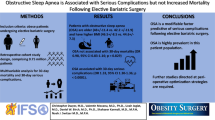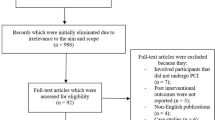Abstract
Background
Obstructive sleep apnea (OSA) is a frequent comorbid condition in patients with type 2 diabetic (T2DM). Concomitant OSA is associated with a detrimental impact on metabolic control. Both OSA and T2DM independently lead to increased cardiovascular disease and mortality. The impact of OSA on the acceleration of organ dysfunction leading to increased healthcare utilization is unknown.
Methods
This is a retrospective case–control cohort study, a secondary analysis utilizing a nationwide dataset. Patients who underwent elective surgical procedures from 2009 to 2014 were identified. Among these patients, we compared patients with obstructive sleep apnea and those without obstructive sleep apnea. Exact 1:1 matching was performed based on similar characteristics such as age, sex, geographic location, surgical facility environment, performing surgeon, and severity of illness during hospitalization. The subgroup of patients with T2DM with or without OSA was analyzed for post-discharge hospital admissions, intensive care unit (ICU) admissions, emergency room (ER) visits, and outpatient visits.
Results
Among 47,719 matched patients of the initial study, this subgroup included 4,567 patients with diabetes and OSA and 3,842 patients with diabetes but no OSA. In the presence of comorbid OSA, patients with T2DM had higher odds of increased healthcare utilization among all the outcomes: inpatient visits increased with an odds ratio of 2.50 (confidence interval (CI) 2.28–2.74) and ICU admissions 1.96 (CI 1.73–2.25) ER 1.93 **(CI 1.75–2.12) and outpatient visits 2.18 (CI 2.00–2.38). Future healthcare utilization per 100 patient-years was also increased significantly among all outcomes (p < 0.0001).
Conclusions
In patients with diabetes undergoing elective surgery, the presence of OSA was associated with higher future healthcare utilization.

Similar content being viewed by others
References
Morgenstern M, Wang J, Beatty N, Batemarco T, Sica AL, Greenberg H (2014) Obstructive sleep apnea: an unexpected cause of insulin resistance and diabetes. Endocrinol Metab Clin North Am 43:187–204
Koren D, O’Sullivan KL, Mokhlesi B (2015) Metabolic and glycemic sequelae of sleep disturbances in children and adults. Curr Diab Rep 15:562
Kent BD, Grote L, Ryan S et al (2014) Diabetes mellitus prevalence and control in sleep-disordered breathing: the European Sleep Apnea Cohort (ESADA) study. Chest 146:982–990
Tahrani AA, Ali A, Raymond NT et al (2012) Obstructive sleep apnea and diabetic neuropathy: a novel association in patients with type 2 diabetes. Am J Respir Crit Care Med 186:434–441
Stadler S, Jalili S, Schreib A et al (2018) Association of sleep-disordered breathing with severe chronic vascular disease in patients with type 2 diabetes. Sleep Med 48:53–60
Leong WB, Jadhakhan F, Taheri S, Thomas GN, Adab P (2016) The association between obstructive sleep apnea on diabetic kidney disease: a systematic review and meta-analysis. Sleep 39:301–308
Altaf QA, Dodson P, Ali A et al (2017) Obstructive sleep apnea and retinopathy in patients with type 2 diabetes A longitudinal study. Am J Respir Crit Care Med 196:892–900
Agrawal R, Spiegelman AM, Bandi VD, Hirshkowitz M, Sharafkhaneh A (2021) Healthcare utilization after elective surgery in patients with obstructive sleep apnea - analysis of a nationwide data set. Sleep Med 81:294–299
Moore BJ, White S, Washington R, Coenen N, Elixhauser A (2017) Identifying increased risk of readmission and in-hospital mortality using hospital administrative data: the AHRQ Elixhauser comorbidity index. Med Care 55:698–705
Reutrakul S, Mokhlesi B (2017) Obstructive sleep apnea and diabetes: a state of the art review. Chest 152:1070–1086
Doumit J, Prasad B (2016) Sleep Apnea in Type 2 Diabetes. Diabetes Spectr 29:14–19
Bironneau V, Tamisier R, Trzepizur W et al (2020) Sleep apnoea and endothelial dysfunction: an individual patient data meta-analysis. Sleep Med Rev 52:101309
Labarca G, Dreyse J, Salas C, Schmidt A, Rivera F, Letelier F, Jorquera J (2021) Risk of mortality among patients with moderate to severe obstructive sleep apnea and diabetes mellitus: results from the SantOSA cohort. Sleep Breath 25(3):1467–1475. https://doi.org/10.1007/s11325-020-02283-y
Wang H, Li X, Tang Z, Gong G (2020) Cardiovascular outcomes post percutaneous coronary intervention in patients with obstructive sleep apnea and type 2 diabetes mellitus: a systematic review and meta-analysis. Diabetes Ther 11:1795–1806
Johnson EK, Nelson CP (2013) Values and pitfalls of the use of administrative databases for outcomes assessment. J Urol 190:17–18
Acknowledgements
We thank Eve Shaffer for her contributions.
Funding
This material is the result of work supported with resources and the use of facilities at the Michael E. DeBakey Veteran Affairs Medical Center, Houston, TX. The deidentified data was provided by the Advisory Board Company. The contents do not represent the views of the US Department of Veterans Affairs or the United States Government.
u.s. department of veterans affairs
Author information
Authors and Affiliations
Corresponding author
Ethics declarations
Ethics approval
This research was approved by the Institutional Review Board of Baylor College of Medicine and the Research and Development Committee of Michael E. DeBakey Veteran Affairs Medical Center. All procedures performed in studies involving human participants were in accordance with the ethical standards of the institutional and/or national research committee and with the 1964 Helsinki declaration and its later amendments or comparable ethical standards. This type of study does not require informed consent.
Conflict of interest
The authors declare no competing interests.
Additional information
Publisher's Note
Springer Nature remains neutral with regard to jurisdictional claims in published maps and institutional affiliations.
Rights and permissions
About this article
Cite this article
Agrawal, R., Spiegelman, A.M., Bandi, V.D. et al. Obstructive sleep apnea in diabetic patients is associated with higher healthcare utilization. Sleep Breath 26, 1817–1820 (2022). https://doi.org/10.1007/s11325-021-02552-4
Received:
Revised:
Accepted:
Published:
Issue Date:
DOI: https://doi.org/10.1007/s11325-021-02552-4




